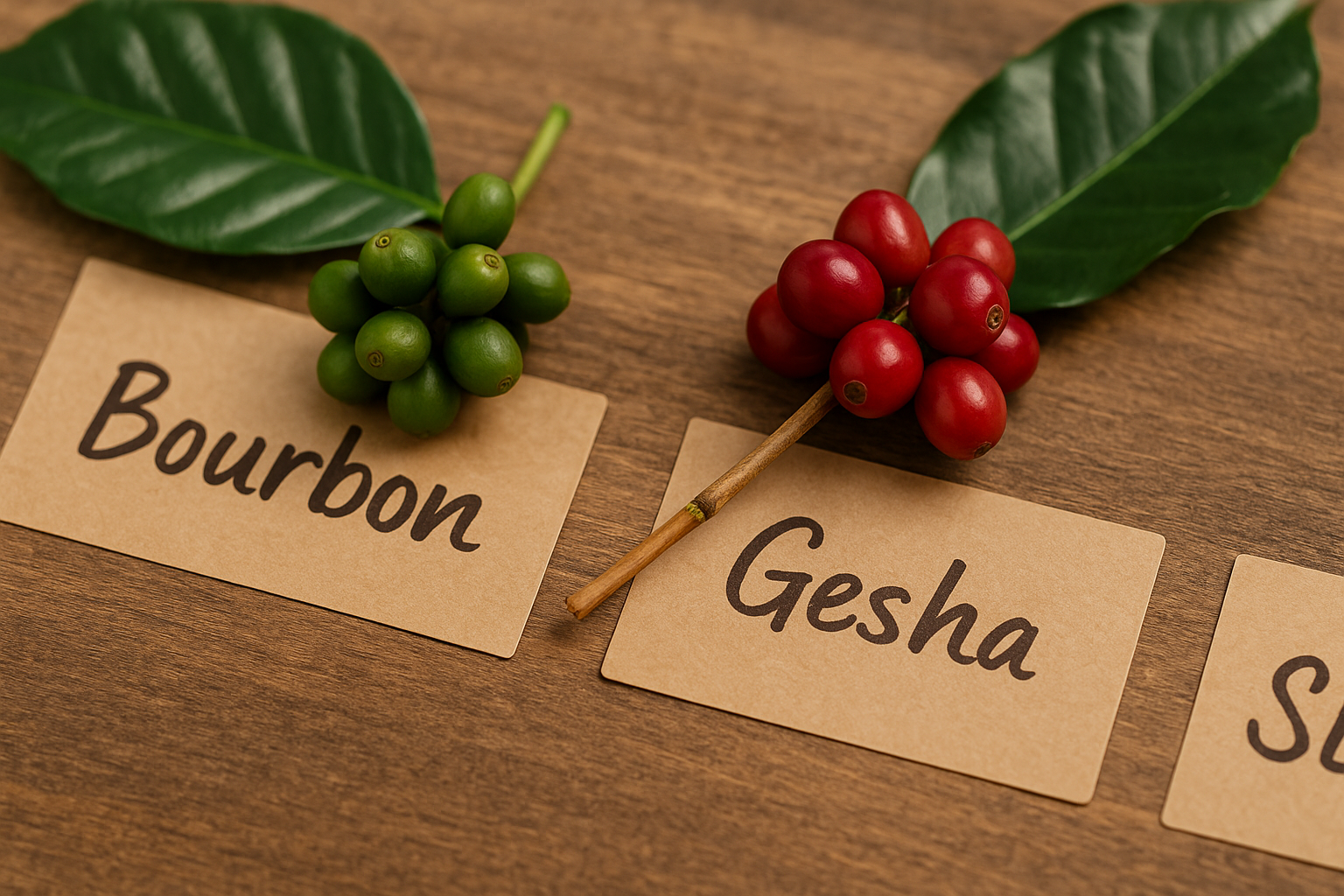When you step into the world of specialty coffee, it doesn’t take long before you hear words like Bourbon, Typica, Geisha, and SL28.
These aren’t brand names or blends — they’re coffee varietals, and they play a massive role in how your coffee tastes.
As a barista, understanding coffee varietals can give you deeper insight into origin characteristics, help you appreciate flavor diversity, and allow you to speak more confidently with customers and coffee professionals.
Let’s explore what coffee varietals are, why they matter, and how to identify their unique traits.
What Is a Coffee Varietal?
A coffee varietal (or variety) refers to a genetic sub-group of the coffee species. In specialty coffee, we mostly deal with Arabica, which has hundreds of distinct varietals.
Think of varietals like grape varieties in wine. Just like Pinot Noir and Cabernet Sauvignon produce different wines, Bourbon and Geisha produce very different coffees.
Varietals develop naturally through evolution or are selectively bred by farmers and scientists for specific traits like yield, flavor, disease resistance, or climate adaptability.
Understanding them helps you trace a coffee’s story from seed to cup.
Why Varietals Matter in Specialty Coffee
Varietals influence several key elements of a coffee’s profile:
- Flavor: Some varietals produce bright, fruity coffees; others lean toward chocolate, spice, or floral notes.
- Sweetness and Acidity: Each varietal has a different balance depending on its structure and ripening process.
- Mouthfeel: The body of the coffee can range from tea-like to syrupy based on varietal.
- Adaptability: Certain varietals grow better at specific altitudes, climates, or soil types.
- Yield and Resistance: Farmers choose varietals based on how much fruit they produce and how resilient they are against pests or disease.
For baristas, knowing this helps you understand why a Kenyan SL28 tastes different from a Colombian Castillo, even when processed similarly.
Heirloom vs. Hybrid Varietals
Coffee varietals generally fall into two main categories:
Heirloom (Traditional or Indigenous)
These are older, naturally occurring varietals that have not been cross-bred. They often offer exceptional cup quality but may be lower-yielding or more vulnerable to disease.
Examples: Typica, Bourbon, SL28, Geisha, Ethiopian Landraces
Hybrid (Cultivated Crosses)
These varietals are intentionally bred for higher yields, resistance to pests, or climate adaptability. While sometimes less complex in flavor, modern hybrids are essential for sustainability.
Examples: Catimor, Caturra, Castillo, Sarchimor, Marsellesa
Many specialty farms now focus on hybrids that balance cup quality and resilience, which is vital in the face of climate change.
Common Coffee Varietals and Their Characteristics
Here are some of the most notable Arabica varietals you’ll encounter in specialty coffee — each with its own set of traits.
1. Bourbon
- Origin: Yemen, via the island of Bourbon (now Réunion)
- Flavor: Sweet, balanced, often with notes of chocolate, caramel, and mild fruit
- Body: Medium
- Preferred Elevation: 1,000–2,000 masl
Bourbon is one of the oldest and most respected varietals. It’s the parent of many modern hybrids and prized for its clean and classic profile.
2. Typica
- Origin: Ethiopia → Yemen → Java → Americas
- Flavor: Clean, sweet, and mild with floral undertones
- Body: Light to medium
- Vulnerability: Low yield, disease-prone
Typica is the base varietal from which many others were developed. It’s not as common today but is still cultivated by some specialty farms for its cup quality.
3. SL28
- Origin: Kenya (Scott Agricultural Laboratories)
- Flavor: Bright acidity, notes of blackcurrant, citrus, and wine
- Body: Medium to full
- Strength: Drought-resistant, but disease-sensitive
SL28 is often grown in high-altitude Kenyan farms. Its intense flavor and juicy profile make it one of the most exciting coffees for baristas and coffee lovers alike.
4. SL34
- Origin: Kenya
- Flavor: Rich, deep sweetness with slightly less acidity than SL28
- Body: Full
- Strength: Performs well in wet conditions
SL34 is often paired with SL28 in Kenyan coffees. It offers body and balance while still preserving complexity.
5. Geisha (or Gesha)
- Origin: Ethiopia, popularized in Panama
- Flavor: Floral, jasmine, bergamot, tropical fruits
- Body: Light and tea-like
- Cost: Extremely high due to rarity and demand
Geisha is considered one of the most prized varietals in the world. When grown in the right conditions, it produces breathtaking complexity and clarity. Often used in competitions.
6. Caturra
- Origin: Brazil (mutation of Bourbon)
- Flavor: Bright, crisp, and balanced; citrus and chocolate notes
- Trait: Dwarf plant; good for high-density planting
Caturra is widely grown in Latin America. It maintains much of Bourbon’s sweetness but grows more compactly, allowing for easier harvesting.
7. Castillo
- Origin: Colombia (bred for rust resistance)
- Flavor: Nutty, mild fruit, and chocolate; less complex than Typica or Bourbon
- Strength: High yield, disease-resistant
Castillo was designed to help Colombian farmers recover from disease outbreaks. Some specialty versions of Castillo now score very well in cuppings.
8. Pacamara
- Origin: Hybrid of Pacas and Maragogipe (El Salvador)
- Flavor: Bold and complex; can include stone fruit, spice, and floral notes
- Beans: Very large in size
- Trait: High potential but inconsistent quality
Pacamara is loved for its unusual size and intense flavor. When well-processed, it creates memorable cups with rich body and complexity.
How Varietals Interact With Terroir and Processing
A varietal’s flavor is not just in its genetics — it’s shaped by the terroir (climate, soil, altitude) and processing method (washed, natural, honey, etc.).
For example, a Bourbon grown in El Salvador at 1,400 masl and washed will taste different from the same Bourbon grown in Rwanda at 1,800 masl and processed naturally.
As a barista, pay attention to how the same varietal expresses itself in different regions. This helps you compare coffees more precisely and recommend them based on customer taste preferences.
How to Identify Varietals as a Barista
Most specialty coffee bags include varietal information. When it’s missing, you can ask the roaster or supplier for details.
Here’s how to make varietals part of your service:
- Educate yourself: Taste coffees from the same varietal grown in different regions.
- Practice cupping: Focus on flavor traits linked to each varietal.
- Talk to roasters: Learn why they selected a specific varietal.
- Explain simply to customers: “This is a Geisha — it’s very floral and delicate, almost like tea.”
This not only enhances the customer experience but positions you as a knowledgeable, trustworthy barista.
Are Some Varietals Better Than Others?
It depends on what you’re looking for. Geisha may score higher in competitions, but a well-grown Caturra or SL28 can offer more crowd-pleasing balance.
In specialty coffee, the question isn’t just “what’s best?” — it’s what’s appropriate for the context, brew method, and customer.
Some varietals shine in pour-overs; others are ideal for espresso or cold brew. Learning these nuances will help you build a better coffee menu and personalize recommendations.
Final Thoughts: Varietals Are Your Flavor Foundation
Understanding coffee varietals adds depth to your craft. It connects you to the plant, the farmer, and the flavor in the cup. It also gives you a powerful tool for making better decisions — from choosing beans to dialing in recipes and sharing stories with customers.
So next time you see a coffee labeled “SL28” or “Bourbon,” don’t just nod and smile. Take a moment to think about what that means — for the plant, the farmer, and the person enjoying the drink.
This is what makes specialty coffee special: every bean has a name, a history, and a flavor waiting to be discovered.

Marcelo Rodrigues is a passionate barista with over 7 years of experience in specialty coffee. He’s worked in top cafés, led barista training sessions, and now shares practical tips to help beginners and coffee lovers improve their skills. Through this blog, Marcel makes the world of coffee more accessible—one cup at a time.

